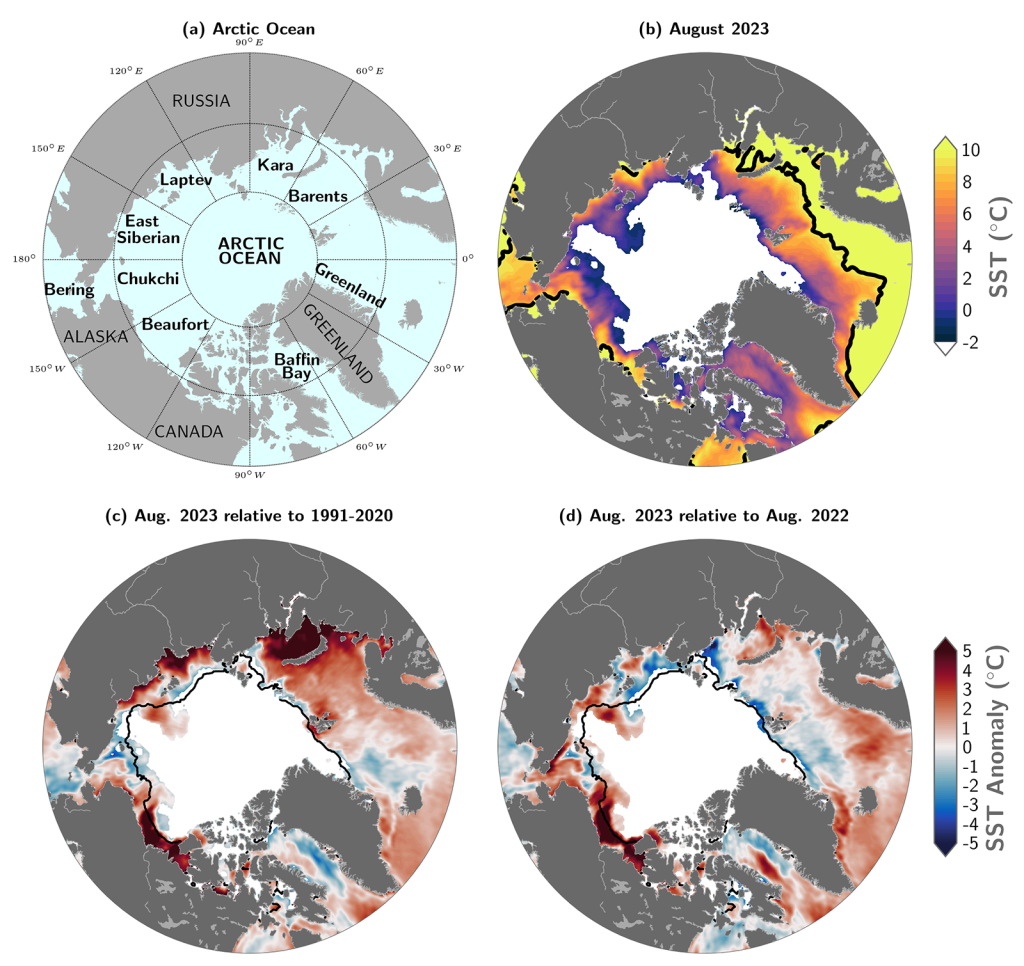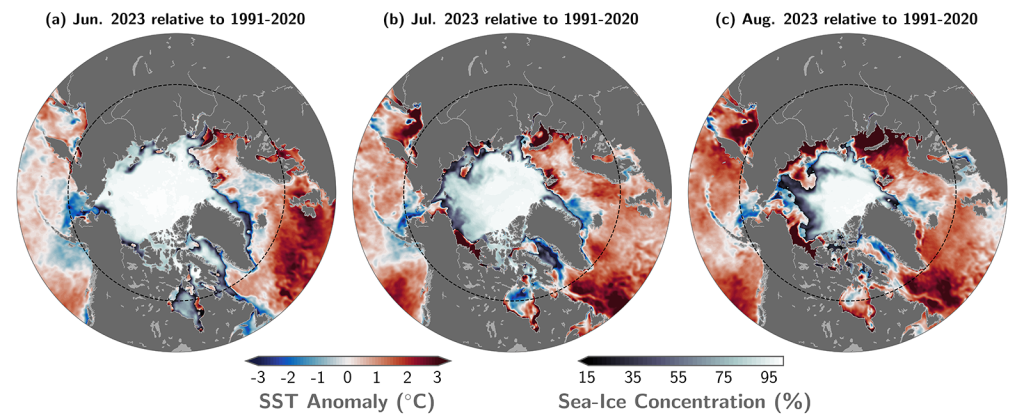M. -L. Timmermans1 and Z. Labe2
1Yale University, New Haven, CT, USA
2Atmospheric and Oceanic Sciences Program, Princeton University, Princeton, NJ, USA
Headlines
- August 2023 mean sea surface temperatures (SSTs) were ~5-7°C warmer than 1991-2020 August mean values in the Barents, Kara, Laptev and Beaufort Seas.
- Anomalously cool August 2023 SSTs (~1-3°C cooler) were observed in Baffin Bay, the Greenland Sea and parts of the Chukchi Sea.
- August mean SSTs show warming trends for 1982-2023 in almost all Arctic Ocean regions that are ice-free in August, with mean SST increases over regions between 65° N and 80° N of ~0.5°C per decade.
Arctic Ocean sea surface temperatures (SSTs) in the summer (June-August) are driven by the amount of incoming solar radiation absorbed by the sea surface and by the flow of warm waters into the Arctic from the North Atlantic and North Pacific Oceans. Solar warming of the Arctic Ocean surface is influenced by sea ice distribution (with greater warming occurring in ice-free regions), cloud cover, and upper-ocean stratification. Discharge of relatively warm Arctic river waters can provide an additional heat source to the surface of marginal seas.
Arctic SST is an essential indicator of the role of the ice-albedo feedback cycle in any given summer sea ice melt season. As the sea ice cover decreases, more incoming solar radiation is absorbed by the darker ocean surface and, in turn, the warmer ocean melts more sea ice. In addition, higher SSTs are associated with delayed autumn freeze-up and increased ocean heat storage throughout the year. Marine ecosystems are also influenced by SSTs, which affect primary production and available habitat.
Here we present August 2023 mean SSTs in context with the climatological record. The SST data analyzed are monthly mean values for August (1982-2023) (see Reynolds et al. 2002, 2007; Huang et al. 2021), and comparisons are made to the 1991-2020 baseline period (see Methods and data). August mean SSTs provide the most appropriate representation of Arctic Ocean summer SSTs because sea-ice extent is near a seasonal low at this time of year, and there is not the influence of surface cooling and subsequent sea-ice growth that takes place in the latter half of September.
August 2023 mean SSTs were as warm as ~11°C in the Barents, Kara, and Beaufort Seas and reached values as warm as ~8°C in other Arctic basin marginal regions (eastern Chukchi Sea and Laptev Sea, Fig. 1a,b). August 2023 mean SSTs were anomalously warm compared to the 1991-2020 August mean (around 5-7°C warmer) in the Barents, Kara, Laptev, and Beaufort Seas, and anomalously cool in Baffin Bay and parts of the Greenland and Chukchi Seas (around 1-3°C cooler than the 1991-2020 mean; Fig. 1c). These regional variations vary significantly from year-to-year. For example, there were considerably warmer SSTs in the Beaufort Sea in August 2023 compared to August 2022, with differences of up to 7°C (Fig. 1d).

Warm river inflows may have influenced marginal sea SSTs with anomalously warm August 2023 SSTs in the Beaufort Sea where the Mackenzie River enters, in the Kara Sea in the vicinity of the Ob and Yenisei River outflows, and in the Laptev Sea where the Lena River enters (Fig. 1c). This corresponds with anomalously warm surface air temperatures in June-August 2023 over northern North America and Siberia (see essay Surface Air Temperature).
The above normal August 2023 SSTs in the Beaufort Sea, which were also observed in July (Fig. 2b), relate to relatively low August 2023 sea-ice concentrations in the region (second only to the record low August 2012 conditions for the area extending from the Beaufort to East Siberian Seas; see essay Sea Ice). The timing of seasonal sea-ice retreat from the Beaufort Sea, where sea ice was almost entirely absent by July 2023 (Fig. 2), also links to warm SSTs via the ice-albedo feedback (see essay Sea Ice).


The cooler-than-normal August 2023 SSTs in Baffin Bay are commensurate with below normal surface air temperatures in the region in June-August 2023 (see essay Surface Air Temperature). Early summer sea-ice extent in Baffin Bay was close to the climatological average, with almost full ice cover in June 2023 (Fig. 2a), which is further consistent with the anomalously cool SSTs (see essay on Sea Ice).
The Arctic Ocean has experienced mean August SST warming trends from 1982 to 2023, with statistically significant (at the 95% confidence interval) linear warming trends in almost all regions (Fig. 3a). Mean August SSTs for the Arctic Ocean and marginal seas between 65° N and 80° N exhibit a linear warming trend of 0.05 ± 0.01°C/year (Fig. 3b; SSTs for 80° N-90° N are omitted since this region is largely perennially ice covered). Even while anomalously cool SSTs in Baffin Bay were prominent in August 2023 (Fig. 1c), SSTs show a linear warming trend over 1982-2023 of 0.07 ± 0.02°C/year (Fig. 3c) for this region, although with considerable interannual variability in mean August values.


Methods and data
The SST data presented here are from the 0.25° × 0.25° NOAA Optimum Interpolation Sea Surface Temperature (OISST) Version 2.1 product, a blend of in situ and satellite measurements (Reynolds et al. 2002, 2007; Huang et al. 2021). Details are found here: https://psl.noaa.gov/data/gridded/data.noaa.oisst.v2.highres.html. The datafile “sst.mon.mean.nc” (comprising monthly means from the daily data) was retrieved from: https://downloads.psl.noaa.gov/Datasets/noaa.oisst.v2.highres/, [accessed 4 September 2023]. The period of analysis is June 1982 to August 2023, with 1991-2020 used as the climatological reference period for the June, July, and August means.
OISST Version 2.1 (v2.1) replaced the 1° × 1° NOAA OISST Version 2 (v2), which was discontinued in January 2023. Version 2.1 is the same as v2 (aside from the horizontal resolution difference) for the period prior to 1 January 2016. After 1 January 2016, v2.1 differs from v2 in multiple ways, including different correction methods and buoy datasets used (see Huang et al. 2021 for a full description). Notably for interpretation of Arctic Ocean SSTs, v2.1 employs a different method than v2 for setting a proxy SST in sea-ice covered regions. Version 2 uses a linear relationship with sea-ice concentration to infer SST under sea ice (Reynolds et al. 2007), while v2.1 modifies this (following Banzon et al. 2020) to set SST equal to the freezing temperature (computed using a climatological sea-surface salinity) where ice concentrations are greater than 35%. We focus primarily on waters that are ice free in August, although the uncertainty in inferring SSTs (and SST trends) may be significant in the vicinity of the sea-ice edge, which varies in location each year.
For comparison with previous-year SST sections of the Arctic Report Card (e.g., Timmermans and Labe 2022), which used monthly-mean v2, we briefly note some important differences by way of example: comparison of the monthly mean August 2022 SST anomaly (relative to 1991-2020) between v2 (Fig. 4a) and v2.1 (Fig. 4b). The broad spatial patterns and their magnitudes are similar between the two products (e.g., generally cooler waters in the Norwegian Sea and the vicinity of Bering Strait, and warmer waters in the Barents and Laptev Seas). However, there are notable differences in the vicinity of the ice edge; for example, Beaufort Sea temperatures adjacent to the ice edge are ~2°C cooler in v2.1. This likely results from differences in the algorithm for proxy SST in the presence of sea-ice cover, and the differences in resolution between v2 and v2.1. Other notable areas are the marginal seas off the coast of Siberia where SSTs are warmer in v2.1. The source of these differences is unclear, although Huang et al. (2021) present a detailed analysis of differences in long-term averages between the two products. Nevertheless, the trends in August mean SSTs reported here (Fig. 3b,c) are statistically indistinguishable between v2 and v2.1, lending confidence to the conclusions and consistency with past Arctic Report Cards.


Sea ice concentration data are the NOAA/NSIDC Climate Data Record of Passive Microwave Sea Ice Concentration, Version 4 (https://nsidc.org/data/g02202) for the 1982-2022 period of record, and Near-Real-Time NOAA/NSIDC Climate Data Record of Passive Microwave Sea Ice Concentration, Version 2 (https://nsidc.org/data/g10016) (Peng et al. 2013; Meier et al. 2021a,b) is used for June-August 2023, where a threshold of 15% concentration is used to calculate sea ice extent.
Acknowledgments
M. -L. Timmermans acknowledges support from the National Science Foundation Office of Polar Programs and the Office of Naval Research. Z. Labe acknowledges support under award NA18OAR4320123 from the National Oceanic and Atmospheric Administration, U.S. Department of Commerce.
References
Banzon, V., T. M. Smith, M. Steele, B. Huang, and H. -M. Zhang, 2020: Improved estimation of proxy sea surface temperature in the Arctic. J. Atmos. Ocean. Tech., 37, 341-349, https://doi.org/10.1175/JTECH-D-19-0177.1.
Huang, B., C. Liu, V. Banzon, E. Freeman, G. Graham, B. Hankins, T. Smith, and H. Zhang, 2021: Improvements of the Daily Optimum Interpolation Sea Surface Temperature (DOISST) Version 2.1. J. Climate, 34(8), 2923-2939, https://doi.org/10.1175/JCLI-D-20-0166.1.
Meier, W. N., F. Fetterer, A. K. Windnagel, and J. S. Stewart, 2021a: NOAA/NSIDC Climate Data Record of Passive Microwave Sea Ice Concentration, Version 4. [1982-2021]. NSIDC: National Snow and Ice Data Center, Boulder, CO, USA, accessed 10 September 2022, https://doi.org/10.7265/efmz-2t65.
Meier, W. N., F. Fetterer, A. K. Windnagel, and J. S. Stewart, 2021b: Near-Real-Time NOAA/NSIDC Climate Data Record of Passive Microwave Sea Ice Concentration, Version 2. [1982-2021], accessed 10 September 2022, https://doi.org/10.7265/tgam-yv28.
Peng, G., W. N. Meier, D. J. Scott, and M. H. Savoie, 2013: A long-term and reproducible passive microwave sea ice concentration data record for climate studies and monitoring. Earth Syst. Sci. Data, 5, 311-318, https://doi.org/10.5194/essd-5-311-2013.
Reynolds, R. W., N. A. Rayner, T. M. Smith, D. C. Stokes, and W. Wang, 2002: An improved in situ and satellite SST analysis for climate. J. Climate, 15, 1609-1625, https://doi.org/10.1175/1520-0442(2002)015<1609:AIISAS>2.0.CO;2.
Reynolds, R. W., T. M. Smith, C. Liu, D. B. Chelton, K. S. Casey, and M. G. Schlax, 2007: Daily high-resolution-blended analyses for sea surface temperature. J. Climate, 20, 5473-5496, https://doi.org/10.1175/2007JCLI1824.1, and see http://www.esrl.noaa.gov/psd/data/gridded/data.noaa.oisst.v2.html.
Timmermans, M. -L., and Z. M. Labe, 2022: Sea surface temperature. Arctic Report Card 2022, M. L. Druckenmiller, R. L. Thoman, and T. A. Moon, Eds., https://doi.org/10.25923/p493-2548.
November 13, 2023
